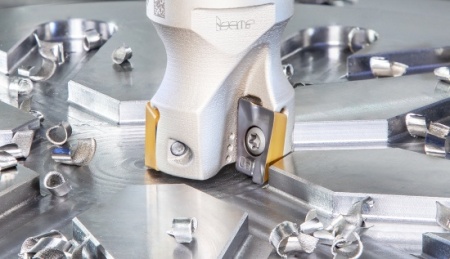
Andrei Petrilin, Technical Manager of ISCAR showcases its new developments for aircraft machining of tomorrow.
In machining aerospace components, the main challenges relate to component materials. Titanium, high-temperature superalloys (HTSA), and creep-resisting steel are difficult to cut and machining is a real bottleneck in the whole aircraft supply chain. Poor machinability of these materials results in low cutting speeds, which significantly reduces productivity and shortens tool life. Both these factors are directly connected with cutting tools.
In fact, when dealing with hard-to-machine typical aerospace materials, cutting tool functionality defines the existing level of productivity. The truth is, cutting tools in their development lag machine tools, and this development gap limits the capabilities of leading-edge machines in the manufacturing of aerospace components.
Modern aircraft, especially unmanned aerial vehicles (UAV), feature a considerably increased share of composite materials. Effective machining composites demand specific cutting tools, which is the focus of a technological leap in the aerospace industry.
Aircraft-grade aluminum continues to be a widely used material for fuselage elements. It may seem that machining aluminum is simple, however, selecting the right cutting tool is a necessary key to success in high-efficiency machining of aluminum.
A complex part shape is a specific feature of the turbine engine technology. Most geometrically complicated parts of aero engines work in highly corrosive environments and are made from hard-to-cut materials, such as titanium and HTSA, to ensure the required life cycle. A combination of complex shape, low material machinability, and high accuracy requirements are the main difficulties in producing these parts. Leading multi-axis machining centers enable various chip removal strategies to provide complex profiles in a more effective way. But a cutting tool, which comes into direct contact with a part, has a strong impact on the success of machining. Intensive tool wear affects surface accuracy, while an unpredictable tool breakage may lead to the discarding of a whole part.
A cutting tool – the smallest element of a manufacturing system – turns into a key pillar for substantially improved performance. Therefore, aerospace part manufacturers and machine tool builders are waiting for innovative solutions for a new level of chip removal processes from their cutting tool producers. The solution targets are evident: more productivity and more tool life. Machining complex shapes of specific aerospace parts and large-sized fuselage components demand a predictable tool life period for reliable process planning and a well-timed replacement of worn tools or their exchangeable cutting components.
Coolant jet
In machining titanium, HTSA and creep-resisting steel, high pressure cooling (HPC) is an efficient tool for improving performance and increasing productivity. Pinpointed HPC significantly reduces the temperature at the cutting edge, ensures better chip formation and provides small, segmented chips. This contributes to higher cutting data and better tool life when compared with conventional cooling methods. More and more intensive applying HPC to machining difficult-to-cut materials is a clear trend in manufacturing aerospace components. Understandably, cutting tool manufacturers consider HPC tooling an important direction of development.
ISCAR, one of leaders in cutting tool manufacturing, has a vast product range for machining with HPC. In the last year, ISCAR has expanded its range by introducing new milling cutters carrying “classical” HELI200 and HELIMILL indexable inserts with 2 cutting edges (Fig. 1). This step brings an entire page of history to ISCAR’s product line.
The HELIMILL was modified and underwent changes which led to additional milling families and inserts with more cutting edges. The excellent performance and its close derivatives of the original tools ensured their phenomenal popularity in metalworking. Therefore, by adding a modern HPC tool design to the proven HELIMILL family was a direct response to customer demand and the next logical tool line to develop.
In Turning, ISCAR considerably expanded its line of assembled modular tools comprising of bars and exchangeable heads with indexable inserts. The bars have both traditional and anti-vibration designs and differ by their adaptation: cylindrical or polygonal taper shank. A common feature for the nodular tools is the delivery of internal coolant to be supplied directly to the required insert cutting edge (Fig. 2). The efficient distribution of coolant increases the insert’s tool life by reducing the temperature and improving chip control and chip evacuation; substantially increasing this application line in the aerospace industry.




